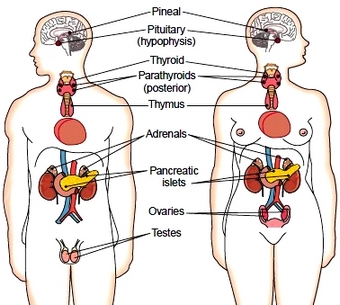The Sex Glands
The sex glands, the female ovaries and the male testes, not only produce the sex cells but also are important endocrine organs. The hormones produced by these organs are needed in the development of the sexual characteristics, which usually appear in the early teens, and for the maintenance of the reproductive organs once full development has been attained. Those features that typify a male or female other than the structures directly concerned with reproduction are termed secondary sex characteristics. They include a deep voice and facial and body hair in males, and wider hips, breast development, and a greater ratio of fat to muscle in females.
Hormones of the Sex Glands The main male sex hormone produced by the testes is testosterone. All male sex hormones are classified as androgens. In the female, the hormones that most nearly parallel testosterone in their actions are the estrogens, produced by the ovaries. Estrogens contribute to the development of the female secondary sex characteristics and stimulate mammary gland development, the onset of menstruation, and the development and functioning of the reproductive organs. The other hormone produced by the ovaries, called progesterone, assists in the normal development of pregnancy (gestation).
The Thymus Gland
The thymus gland is a mass of lymphoid tissue that lies in the upper part of the chest superior to the heart. This gland is important in the development of immunity. Its hormone, thymosin, assists in the maturation of certain white blood cells known as T cells (T lymphocytes) after they have left the thymus gland and taken up residence in lymph nodes throughout the body.
The Pineal Gland
The pineal gland is a small, flattened, coneshaped structure located posterior to the midbrain and connected to the roof of the third ventricle (see Fig. 8-2). The pineal produces the hormone melatonin during dark periods. Little hormone is produced during daylight hours. This pattern of hormone secretion influences the regulation of sleep-wake cycles.
The thymus gland is a mass of lymphoid tissue that lies in the upper part of the chest superior to the heart. This gland is important in the development of immunity. Its hormone, thymosin, assists in the maturation of certain white blood cells known as T cells (T lymphocytes) after they have left the thymus gland and taken up residence in lymph nodes throughout the body.
The Pineal Gland
The pineal gland is a small, flattened, coneshaped structure located posterior to the midbrain and connected to the roof of the third ventricle (see Fig. 8-2). The pineal produces the hormone melatonin during dark periods. Little hormone is produced during daylight hours. This pattern of hormone secretion influences the regulation of sleep-wake cycles.

Figure 8-2 The endocrine glands.
Other Hormone-Producing Tissues
Originally, the word hormone applied to the secretions of the endocrine glands only. The term now includes various body substances that have regulatory actions, either locally or at a distance from where they are produced. Many body tissues produce substances that regulate the local environment. Some of these other hormone-producing organs are the following:
* The stomach secretes a hormone that stimulates its own digestive activity.
* The small intestine secretes hormones that stimulate the production of digestive juices and help regulate the digestive process.
* The kidneys produce a hormone called erythropoietin, which stimulates red blood cell production in the bone marrow. This hormone is produced when there is a decreased supply of oxygen in the blood.
* The brain, as noted, secretes releasing hormones and release-inhibiting hormones that control the anterior pituitary, as well as ADH and oxytocin that are released from the posterior pituitary.
* The atria (upper chambers) of the heart produce a substance called atrial natriuretic peptide (ANP) in response to their increased filling with blood. ANP increases loss of sodium by the kidneys and lowers blood pressure.
* The placenta produces several hormones during pregnancy.
These cause changes in the uterine lining and, later in pregnancy, help to prepare the breasts for lactation. Pregnancy tests are based on the presence of placental hormones.
Prostaglandins
Prostaglandins are a group of local hormones made by most body tissues. Their name comes from the fact that they were first discovered in male prostate glands. Prostaglandins are produced, act, and are rapidly inactivated in or close to their sites of origin. A bewildering array of functions has been ascribed to these substances. Some prostaglandins cause constriction of blood vessels, bronchial tubes, and the intestine, whereas others cause dilation of these same structures. Prostaglandins are active in promoting inflammation; certain antiinflammatory drugs, such as aspirin, act by blocking the production of prostaglandins. Some prostaglandins have been used to induce labor or abortion and have been recommended as possible contraceptive agents. Overproduction of prostaglandins by the uterine lining (endometrium) can cause painful cramps of the uterine muscle. Treatment with prostaglandin inhibitors has been successful in some cases. Much has been written about these substances, and extensive research on them continues.
Prostaglandins are a group of local hormones made by most body tissues. Their name comes from the fact that they were first discovered in male prostate glands. Prostaglandins are produced, act, and are rapidly inactivated in or close to their sites of origin. A bewildering array of functions has been ascribed to these substances. Some prostaglandins cause constriction of blood vessels, bronchial tubes, and the intestine, whereas others cause dilation of these same structures. Prostaglandins are active in promoting inflammation; certain antiinflammatory drugs, such as aspirin, act by blocking the production of prostaglandins. Some prostaglandins have been used to induce labor or abortion and have been recommended as possible contraceptive agents. Overproduction of prostaglandins by the uterine lining (endometrium) can cause painful cramps of the uterine muscle. Treatment with prostaglandin inhibitors has been successful in some cases. Much has been written about these substances, and extensive research on them continues.
Contacts: lubopitno_bg@abv.bg www.encyclopedia.lubopitko-bg.com Corporation. All rights reserved.
DON'T FORGET - KNOWLEDGE IS EVERYTHING!